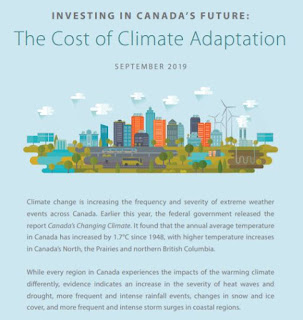 |
| Investing in Canada's Future: The Cost of Climate Adaptation, Report by IBC and FCM, September 2019 |
The report summary "Investing in Canada's Future: The Cost of Climate Adaptation" (link) suggests the following:
"The analysis determined that an average annual investment in municipal infrastructure and local adaptation measures of $5.3 billion is needed to adapt to climate change. In national terms, this represents an annual expenditure of 0.26% of GDP."
"Flood, erosion and permafrost melt are associated with the highest cost to GDP ratios at 1.25, 0.12 and 0.37, respectively. These climate risks require the greatest investment in adaptation."
The infographic summary (link) suggests that " the benefits of investing in community adaptation and resilience outweigh the cost of such investments by a ratio of 6 to 1".
Let's review this in terms of mitigation of flood damages.
The annual expected insured losses from hydrologic and meteorologic events in Canada is $0.7B based on Munich Re data. Overall losses are $1.27B considering Munich Re ratios. Over 100 years that some infrastructure lasts, that is $127B in losses, some that can be effectively mitigated or deferred. If there is a 6:1 benefit:cost ratio to adaptation efforts, then spending $127B/6 = $21.2B would be the cost of the adaptation program to 'break even' (let's assume that is the capital cost and not operation and maintenance).
The IBC FCM study suggests spending of $5.3B per year - a lot more than the 'break even' number -and notes "What is needed now is an ambitious and long-term investment plan for disaster mitigation and adaptation charted along a time frame of not year-to-year, but for the next twenty years or longer."
Let's look at the numbers.
If we invest $5.3B per year for 20 years, that is $106B. So that is a benefit:cost ratio of $127B:$106B or 1:2:1. If we invest $5.3B a year for 25 years, the cost exceeds the benefits. That investment is a lot higher than what we would expect if we achieved a 6:1 benefit:cost ratio, spending only $21.2B.
If we consider that losses cannot be completely deferred with adaptation (as it is rarely 100% effective, and there may always be events that exceed design capacity leaving residual damages, and overall losses cannot be completely deferred), the potential benefits over 100 years may be only $70B, assuming all insured losses can be mitigated. That means spending $5.3B a year for 20 years, or $106B will cost more than the benefits.
This should be carefully reviewed. The value of all municipal storm and wastewater and bridge infrastructure in Canada is $418 B (see my 2018 CWWA presentation here). So investing $106B, or 25% of the value of all that infrastructure value is a lot. Some municipality flood mitigation programs has been estimated at only 6% of asset value.
Setting investment levels appropriately is important and further analysis is needed. It would also be worthwhile distinguishing between the cost to address today's infrastructure capacity and land use planning risks and future risks. Much of Canada's current $0.7B in damages is due to existing level of service deficiencies and not future climate effects.
***
In a previous study Green Analytics acknowledged the difference between damages due to economic growth and those due to future climate effects. It would be worth looking at effects of future growth on damages and consider those in assessing infrastructure investment requirements.